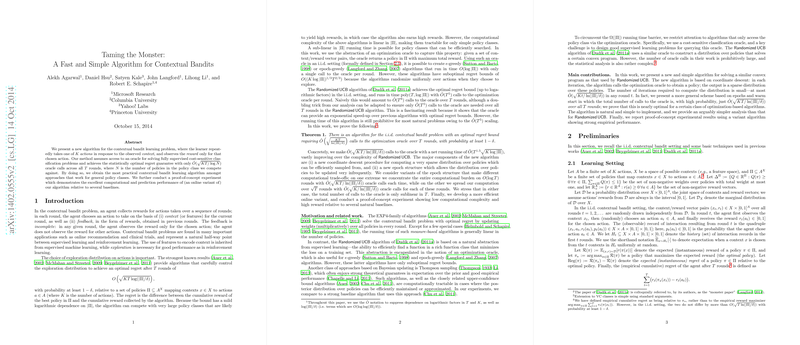Overview of "Taming the Monster: A Fast and Simple Algorithm for Contextual Bandits"
The paper presents a novel algorithm addressing the challenge of contextual bandit learning. Contextual bandit problems are critical in scenarios where an agent must choose actions based on contextual information, yet only receives feedback for the actions taken. These problems sit at the intersection of supervised learning and reinforcement learning, appearing in fields such as online recommendations and clinical trials.
Algorithmic Contribution
The primary contribution is an algorithm that queries an oracle designed to solve fully supervised cost-sensitive classification problems. This algorithm achieves statistically optimal regret bounds with a sublinear number of oracle calls, specifically $\tilde{O}(\sqrt{KT/\log N})$ across $T$ rounds, where $K$ is the number of actions and $N$ is the policy class size. This results in a much more practical approach for handling large and complex policy classes compared to traditional methods that required linear complexity in the number of policies.
Theoretical Foundations
The algorithm relies on a coordinate descent approach within a newly introduced optimization problem framework. This problem is formulated to balance exploration and exploitation through a sparse policy distribution and an epoch-based update mechanism, adjusting the distribution infrequently to manage computational demands.
The paper provides a robust theoretical analysis, ensuring the algorithm's feasibility and regret guarantees. Notably, the computational complexity is driven down to $O(T^{1.5}\sqrt{K\log N})$ through clever scheduling and policy distribution updating strategies, illustrating significant efficiency over previous approaches.
Empirical Evaluation
A proof-of-concept experiment demonstrates the algorithm's computational and predictive performance, outperforming several baseline measures. This experimentation validates the theoretical claims and showcases the practical scalability and adaptability of the proposed method.
Implications and Future Directions
Practically, the paper offers a viable and efficient solution for contextual bandits, enabling applications across vast and complex decision spaces. Theoretically, it highlights the power of optimization oracle reductions in complex learning environments.
Future research may explore direct analysis of the online variant introduced, aiming to further reduce computational complexity. There is potential for integrating more advanced machine learning techniques or exploring applications beyond the initial experimental setup.
Conclusion
This paper contributes meaningfully to contextual bandit research by reducing computational demands while maintaining optimal performance guarantees. The algorithm's design and analysis offer a refined tool for researchers and practitioners working with large-scale, real-world applications requiring dynamic decision-making under uncertainty.
